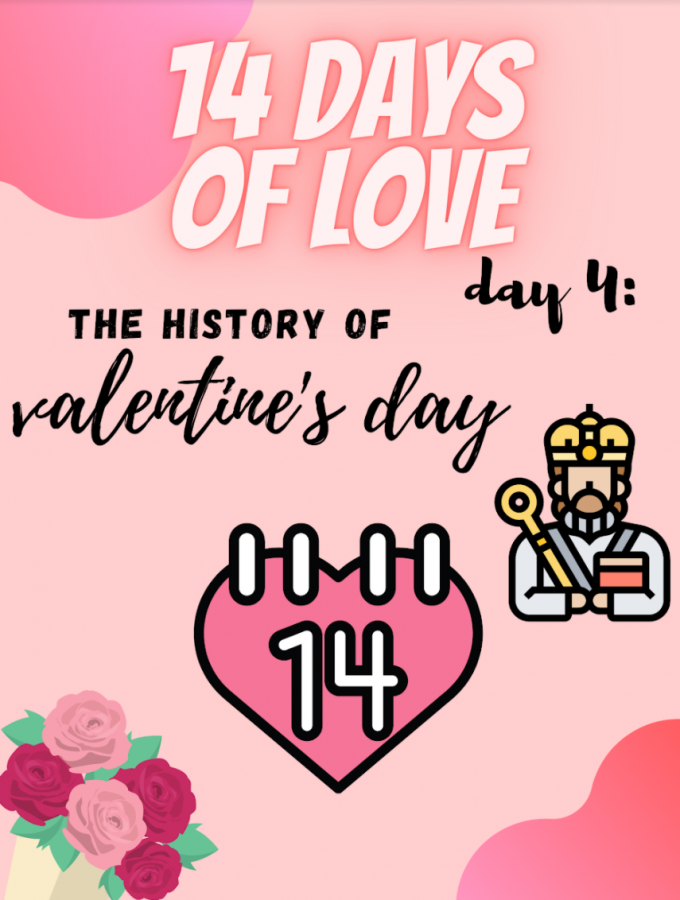14 Days of Love Day 4: The History of Valentine’s Day
February 4, 2021
On Feb. 14, individuals worldwide plan to celebrate Valentine’s Day by sharing boxes of chocolate, flowers, cards and various other gifts to show loved ones that they care. However, not many know the history of the holiday itself, which stems from the patron Saint Valentine and the Roman festival of Lupercalia.
Three different Catholic saints go by a variation of “Valentine” or “Valentinus.” In approximately 270 A.D., a priest by the name of Valentine in Rome met Emperor Claudius II, who executed the now-patron saint on Feb. 14. Claudius also executed another bishop, now-patron saint Valentine of Terni, on Feb. 14 during a different year in the third century A.D. While many have argued who the holiday received its name from, both men received martyrdom from the Catholic Church, which sparked the annual St. Valentine’s Day celebration.
During the third century, Claudius declared that single men were better suited for battle than husbands and fathers, and proceeded to outlaw marriages in Rome for young men. Saint Valentine of Rome strongly objected to the decision and resolved to continue to secretly officiate marriages for young men and women, which led to his subsequent execution on the 14th.
Other legends argue that Valentine served as a sort of “messiah,” aiding Christians in breaking free from Roman imprisonment and cruel punishment. Valentine, during his time in the prison, supposedly sent the very first “Valentine” card to his jailor’s young daughter, who often saw him during his imprisonment. Prior to his execution, he penned a letter to the young girl and signed it “from your Valentine,” which has since turned into an annual tradition.
Many also believe that Valentine’s Day, selected for Feb. 14 by the Catholic Church, aligned with the Lupercalia festival. A possible attempt to bring a religious aspect to the pagan celebration that took place from Feb. 13 to Feb. 15, known as the ides of February, Lupercalia acted as a fertility festival in honor of Fanus, the god of agriculture.
The order of Roman priests known as the Lupreci initiated the festival in the cave, where the famous lupa cared for Romulus and Remus, the future founders of Rome. In memory of the men, the priests sacrificed a goat, symbolizing fertility, and a dog, symbolizing purification.
The hides of both sacrificed animals, drenched in animal blood, were carried to Rome. Due to the nature and purpose of the festival, the priests slapped the women with the animals’ hides. Women appreciated the ritual, as they believed it would increase their fertility within the year.
After the initial ceremony, all young, unwed women placed their names in an urn. Young, unwed men drew a name of a young woman from the urn and paired with the chosen woman for one year, which usually resulted in a marriage.
At the end of the fifth century, Pope Gelasius issued a decree that Feb. 14 would be known as St. Valentine’s Day, which followed the outlaw of the festival of Lupercalia. During the Middle Ages, Valentine’s Day developed a more “romantic” connotation, as the day marked the beginning of the mating season for birds in Europe.
1415 brought history’s very first Valentine greeting card. At the Tower of London after capture at the Battle of Agincourt, Charles, Duke of Orleans, wrote a Valentine to his wife. Royals in the following years also began to write Valentines to their loved ones.
Later on, Valentine’s Day celebrations began in not only the U.S., but Canada, the United Kingdom, France, Mexico and Australia, as well. Currently, Valentine’s Day festivities continue in nations across the world, with people exchanging gifts with one another in celebration of love.
Today, Valentine’s Day is also a significant contributor to the economy. During 2020, the National Retail Federation reported that the U.S. expected to make $27.4 billion from the holiday. The Greeting Card Association and Hallmark also indicated that those who celebrate exchange over 145 million Valentine’s Day cards each year.
Valentine’s Day remains a time-honored tradition where individuals can show their appreciation for those they love. Especially during a pandemic, the holiday acts as a reminder to show appreciation for important people in one’s life.











